Mount Kilimanjaro, the “Roof of Africa,” is a dream destination for adventurers and trekkers from around the globe. Climbing Mount Kilimanjaro: As the highest peak in Africa, standing at 5,895 meters (19,341 feet), Kilimanjaro offers an extraordinary trekking experience. Unlike many other high-altitude mountains, Kilimanjaro requires no technical climbing skills, making it accessible to a wide range of hikers. However, the climb is still a challenge, and preparation is key to reaching the summit successfully.
In this comprehensive guide, we’ll explore everything you need to know about climbing Mount Kilimanjaro, from the different routes to take, how to prepare, and essential tips for a successful ascent.
1. Overview of Mount Kilimanjaro
The Highest Free-Standing Mountain
Kilimanjaro is the highest free-standing mountain in the world, which means it is not part of a mountain range. This dormant volcano, located in northeastern Tanzania near the Kenyan border, is made up of three volcanic cones: Kibo (the highest), Mawenzi, and Shira.
The Ecological Zones
One of the unique aspects of Kilimanjaro is the diversity of ecosystems you’ll encounter as you ascend. The trek begins in lush rainforests, transitions into alpine desert, and ultimately leads to an arctic zone near the summit. This dramatic change in landscape is one of the many reasons why climbing Kilimanjaro is a once-in-a-lifetime adventure.

2. Choosing the Right Route
There are several routes to the summit of Mount Kilimanjaro, each offering different experiences and levels of difficulty. Picking the right route is critical to your success. Here’s an overview of the most popular routes:
Marangu Route (“Coca-Cola Route”)
- Difficulty: Moderate
- Duration: 5-6 days
- Popularity: One of the most popular routes
- Features: The only route with hut accommodations, making it a good choice for those seeking more comfort.
- Pros: Shorter duration, accommodation in huts, scenic beauty.
- Cons: Less time for acclimatization, lower success rate.
Machame Route (“Whiskey Route”)
- Difficulty: Challenging
- Duration: 6-7 days
- Popularity: Most popular route
- Features: Offers incredible scenic views and a varied landscape. It is a longer route, giving you more time to acclimatize.
- Pros: Higher success rate due to longer duration, stunning scenery.
- Cons: Requires more physical effort and endurance.
Lemosho Route
- Difficulty: Challenging
- Duration: 7-8 days
- Popularity: Increasingly popular
- Features: Known for being one of the most beautiful routes. It has a longer approach, giving hikers more time to adjust to the altitude.
- Pros: Higher success rate, fewer crowds, diverse scenery.
- Cons: Longer duration, more expensive due to the extra days.
Rongai Route
- Difficulty: Moderate
- Duration: 6-7 days
- Popularity: Less crowded
- Features: Approaches Kilimanjaro from the north, near the Kenyan border. It is drier and less scenic but offers a gentler ascent.
- Pros: Fewer crowds, gradual ascent.
- Cons: Less scenic compared to other routes, longer descent.
Northern Circuit Route
- Difficulty: Challenging
- Duration: 9-10 days
- Popularity: Least crowded
- Features: The longest and one of the least-traveled routes. It offers a 360-degree trek around the mountain before approaching the summit.
- Pros: Excellent for acclimatization, highest success rate, less crowded.
- Cons: Long duration, more expensive.
3. Preparing for the Climb
Climbing Mount Kilimanjaro requires physical fitness, mental toughness, and proper preparation. Here’s how to get ready for your ascent:
1. Physical Training
While Kilimanjaro doesn’t require technical climbing skills, it’s still a physically demanding trek. Training should begin several months before your trip. Focus on building cardiovascular endurance, strength, and stamina.
- Hiking: The best way to train for Kilimanjaro is to hike regularly. If possible, practice hiking at high altitudes or on varied terrain.
- Cardio Exercises: Running, cycling, and swimming are excellent for improving cardiovascular fitness.
- Strength Training: Focus on building leg and core strength through exercises like squats, lunges, and planks.
- Stair Climbing: Climbing stairs or using a stair machine is great for building the endurance needed for Kilimanjaro’s ascent.
2. Mental Preparation
The mental aspect of climbing Kilimanjaro is just as important as the physical. The altitude, cold temperatures, and long days can take a toll. Stay focused on your goal, and practice positive thinking.
3. Altitude Acclimatization
Altitude sickness is one of the biggest challenges when climbing Kilimanjaro. The key to avoiding it is proper acclimatization. Choose a longer route with more time for your body to adjust to the altitude. Additionally, follow the “climb high, sleep low” principle whenever possible.
4. Gear and Packing
Having the right gear can make or break your Kilimanjaro experience. Here’s a basic packing list:
- Clothing: Layering is key. You’ll need moisture-wicking base layers, insulating mid-layers, and a waterproof outer shell. Don’t forget a warm hat, gloves, and a down jacket for summit night.
- Footwear: Sturdy, broken-in hiking boots are essential. Make sure they’re comfortable and offer good ankle support.
- Backpack: A 30-40L daypack should be sufficient for carrying essentials like water, snacks, and extra layers.
- Hydration System: Staying hydrated is crucial at high altitudes. Bring a hydration bladder or water bottles, and consider using insulated sleeves to prevent freezing.
- Sleeping Bag: A high-quality, four-season sleeping bag rated for cold temperatures is essential.
- Trekking Poles: These help reduce the impact on your knees and provide stability on uneven terrain.
4. Tips for a Successful Summit
Climbing Kilimanjaro is a challenge, but with the right approach, you can maximize your chances of reaching the summit. Here are some essential tips for a successful climb:
1. Go Slow: “Pole Pole”
In Swahili, “pole pole” means “slowly, slowly.” This is the mantra of Kilimanjaro climbers. The higher you climb, the slower you should go. Taking it slow helps your body adjust to the altitude and conserves energy for summit day.
2. Stay Hydrated
Dehydration increases the risk of altitude sickness. Aim to drink 3-4 liters of water per day. Electrolyte powders or tablets can help replenish lost salts and improve hydration.
3. Eat Well
It can be challenging to maintain your appetite at high altitudes, but it’s essential to keep eating. Your body needs fuel to keep going. Pack energy-rich snacks like nuts, energy bars, and dried fruit.
4. Listen to Your Body
Altitude sickness can affect anyone, regardless of fitness level. Symptoms include headaches, nausea, dizziness, and shortness of breath. If you feel any symptoms, let your guide know immediately. They will monitor your condition and decide whether it’s safe to continue.
5. Summit Night: Stay Warm and Focused
Summit night is the most challenging part of the Kilimanjaro climb. You’ll start your ascent around midnight, trekking in the dark and cold for several hours to reach the summit at sunrise. Stay warm by layering properly, keep a steady pace, and focus on putting one foot in front of the other.
6. Respect Your Guides and Porters
The guides and porters on Kilimanjaro are your lifeline. They have extensive experience and know the mountain inside and out. Listen to their advice, respect their decisions, and show gratitude for their hard work.

5. Health and Safety Considerations
Altitude Sickness (AMS)
Altitude sickness is the primary concern when climbing Kilimanjaro. Mild symptoms are common, but serious conditions like High Altitude Pulmonary Edema (HAPE) and High Altitude Cerebral Edema (HACE) can be life-threatening. Always follow your guide’s advice and descend if necessary.
Travel Insurance
Make sure you have travel insurance that covers high-altitude trekking and medical evacuation. Kilimanjaro is a remote area, and in case of an emergency, evacuation can be costly without proper insurance.
Vaccinations and Medications
Before traveling to Tanzania, check with your doctor for any necessary vaccinations or medications. Malaria is prevalent in low-lying areas, so anti-malarial medication may be recommended for your time before or after the climb.
6. Post-Climb Recovery and Relaxation
After conquering Kilimanjaro, reward yourself with some well-deserved relaxation. Tanzania offers numerous opportunities for post-climb recovery:
- Safari in Serengeti or Ngorongoro Crater: Extend your adventure with a wildlife safari in one of Tanzania’s world-renowned national parks.
- Zanzibar: Head to Zanzibar for some beach relaxation. The warm waters and sandy beaches provide the perfect setting to unwind after your climb.
Conclusion
Climbing Mount Kilimanjaro is a challenging yet incredibly rewarding experience. With the right preparation, mindset, and support, you can reach the summit and stand atop Africa’s highest peak. Remember to go “pole pole,” take care of your body, and enjoy every step of this unforgettable journey. Whether you choose the popular Machame route or the scenic Lemosho trail, your Kilimanjaro adventure will be a memory that lasts a lifetime.
For more information or to start planning your Kilimanjaro climb, visit Providence Safari and let us guide you on your adventure to the Roof of Africa!

